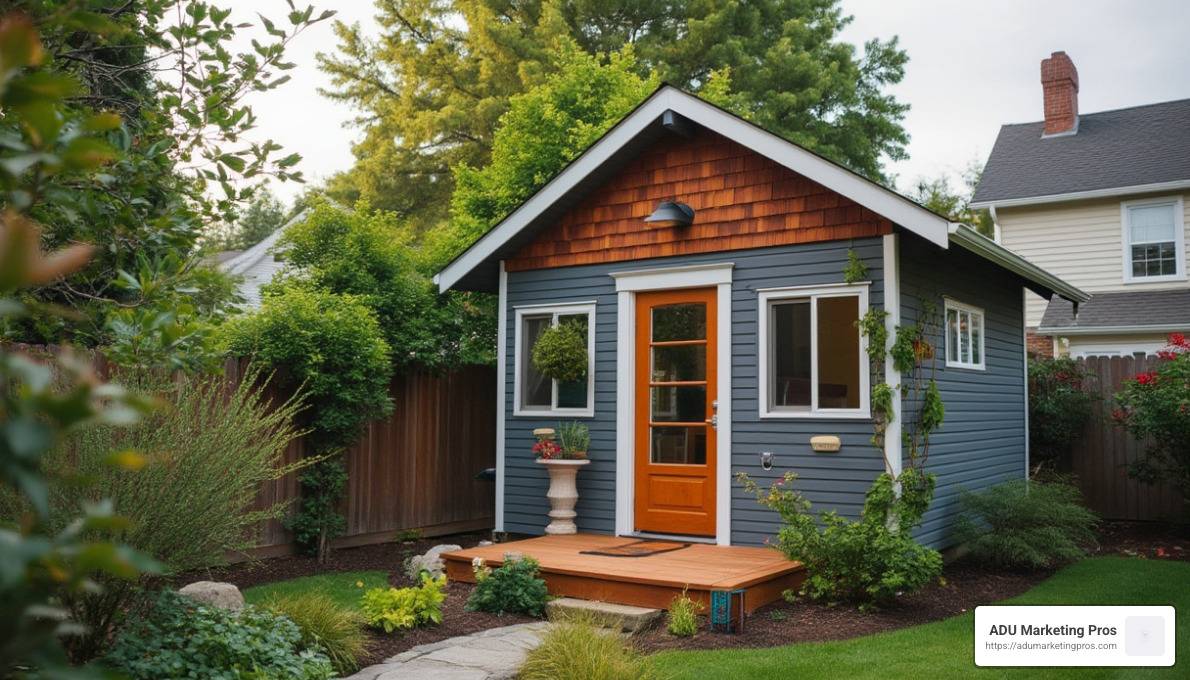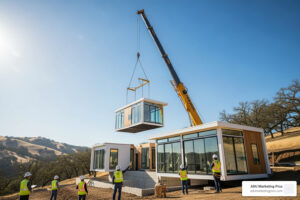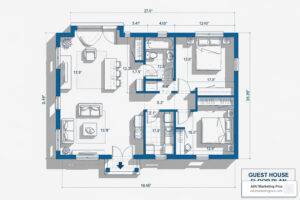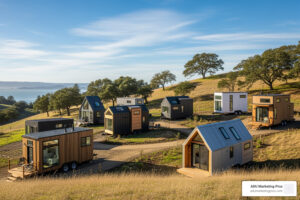ADU Minimum Lot Size is a topic that increasingly draws attention as California’s housing landscape evolves. At its core, an Accessory Dwelling Unit (ADU) is a secondary living space on a lot with a primary home. Imagine a cozy in-law suite, a garage-turned-studio, or a standalone backyard cottage. These units present a flexible and cost-effective solution for housing needs, offering additional space without the need to purchase new land.
In California, laws have recently shifted to support the development of ADUs, aiming to tackle the housing shortage with practical, sustainable solutions. The state now prohibits local governments from enforcing minimum lot size requirements for ADUs, encouraging more people to accept this housing option.
- Main ADU Requirements in California:
- No state-imposed minimum lot size
- Minimum unit size: 150 square feet
- Detached ADUs can be up to 1,200 square feet
ADUs cater to diverse needs, from accommodating family members to generating rental income. Nearly a third of California’s residential neighborhoods have acceptd these changes, optimizing land use and expanding housing opportunities without the hefty price tag of new property purchases.
Understanding ADU requirements and their potential is crucial for navigating California’s updated housing laws. This knowledge helps homeowners and ADU professionals alike to make informed decisions, boosting both community housing options and property values.

Understanding ADU Minimum Lot Size
When it comes to ADU minimum lot size, California has taken a progressive stance. The state does not impose a minimum lot size requirement for building an ADU. This means that homeowners have more flexibility in adding these units to their properties, which is a significant shift aimed at addressing the housing crisis.
No Minimum Requirement
California law prohibits local governments from setting minimum lot sizes for ADUs. This decision opens the door for many homeowners who previously thought they couldn’t add an ADU due to lot size restrictions. By removing these barriers, the state encourages the development of ADUs as a practical solution to increase housing availability.
Local Regulations and Zoning Laws
While there is no state-mandated minimum lot size, local regulations can still play a role. Each city or county may have its own zoning laws that impact ADU construction. These rules might include considerations like:
- Setback requirements: How far the ADU must be from property lines.
- Height restrictions: Limits on how tall the ADU can be.
- Lot coverage: The percentage of the lot that can be covered by structures.
It’s essential for homeowners to consult their local planning department to understand specific zoning laws that may affect their ADU project.
Zoning Laws in Action
Zoning laws are designed to ensure that ADUs fit well within existing neighborhoods. For instance, some areas might allow attached ADUs but restrict detached ones, or vice versa. Others might have aesthetic guidelines to maintain the neighborhood’s character.
Despite these local variations, the overall trend is towards more lenient regulations. This shift reflects the growing recognition of ADUs as a viable solution to housing shortages.

Embracing Flexibility
With California’s supportive stance and evolving local regulations, homeowners have a unique opportunity to add value to their properties through ADUs. Whether it’s for rental income, housing family members, or simply maximizing space, understanding these regulations is key to a successful ADU project.
In the next section, we’ll explore the key considerations for ADU construction, including unit size and design elements.
Key Considerations for ADU Construction
Building an ADU is an exciting endeavor, but it comes with its own set of challenges. Understanding the essentials like unit size, architectural design, and building permits can make the process smoother and more successful.
Unit Size
When planning an ADU, unit size is one of the first factors to consider. In California, the minimum size for an ADU is 150 square feet. However, the maximum size can vary depending on your lot size and local regulations.
For attached units, the ADU can be up to 1,200 square feet or 40% of the primary residence, whichever is less. For detached units, the size depends on the lot:
- 1 acre or more: Up to 1,200 square feet or 40% of the primary residence.
- 12,500 to just under 1 acre: Up to 800 square feet or 40% of the primary residence.
- 7,500 to 12,499 square feet: Up to 600 square feet or 40% of the primary residence.
This flexibility allows homeowners to choose a size that fits their needs and lot constraints.
Architectural Design
The architectural design of your ADU is crucial for both functionality and aesthetics. It’s important to create a space that complements the primary residence and the surrounding neighborhood.
Key design elements to consider include:
- Separate Entrance: An ADU must have its own entrance.
- Bathroom Facilities: At least a 3/4 bath is required.
- Kitchen: Must include permanent provisions for cooking and eating.
Fire safety is another critical design aspect. ADUs must comply with fire and life protection ordinances, but they are not required to have fire sprinklers if the primary residence doesn’t have them.
Building Permits
Navigating the building permit process can be daunting, but it’s a necessary step. In California, permits for ADUs should be reviewed within 60 days of submission. However, if you’re building an ADU alongside a new single-family dwelling (SFD), the city will review the SFD first, and the 60-day timeline for the ADU begins only after that.
-
Historic Districts: If your property is in a historic district, additional reviews and a Certificate of Appropriateness may be required.
-
Garage Conversions: Converting an existing structure, like a garage, into an ADU is often permitted, which can simplify the process.
Understanding these key considerations will help you plan effectively and avoid common pitfalls. By focusing on unit size, design, and permits, homeowners can create a successful ADU project that improves their property and meets their needs.
In the following section, we’ll dive into ADU minimum lot size in California, exploring how state laws and local ordinances shape property requirements.
ADU Minimum Lot Size in California
When it comes to ADU minimum lot size in California, the rules are surprisingly flexible. State laws do not impose a minimum lot size requirement for building an ADU. This means that, technically, you can build an ADU on any size lot. However, local ordinances can affect this flexibility, so it’s important to understand both state and local regulations.
State Laws and Local Ordinances
California has taken significant steps to encourage the development of ADUs by relaxing regulations. The state mandates that local governments cannot enforce minimum lot size requirements for ADUs. This is part of a broader effort to increase housing availability and affordability.
However, each city or county can adopt its own ordinances that might influence where and how ADUs can be built. For instance, some localities may have specific zoning laws that dictate the placement or size of an ADU on a property. These local rules can include:
- Setback Requirements: The distance your ADU must be from property lines.
- Height Restrictions: Limits on how tall your ADU can be.
- Lot Coverage: The total percentage of your lot that can be covered by structures.
It’s crucial to check with your local planning department to understand these specific requirements.
Property Requirements
Beyond lot size, other property requirements can impact your ability to build an ADU. These include:
- Zoning: Your property must be in a zone that permits ADUs. Most residential zones allow them, but it’s always good to verify.
- Utilities: Ensure that your property can support the additional utility needs of an ADU, such as water, sewage, and electricity.
- Parking: While state laws have relaxed parking requirements, local ordinances may still require a certain number of parking spaces, especially if your property is not near public transit.
To steer these requirements effectively, it might be helpful to consult with professionals who specialize in ADU construction and local regulations.
By understanding both state laws and local ordinances, homeowners can ensure their ADU project complies with all necessary regulations. This knowledge not only streamlines the building process but also helps avoid potential legal or logistical issues down the road.
In the next section, we’ll explore the benefits of building an ADU, including how they can provide affordable housing, additional rental income, and increase property value.
Benefits of Building an ADU
Building an Accessory Dwelling Unit (ADU) offers a range of benefits that can positively impact homeowners and communities. Let’s explore some of the most compelling advantages: affordable housing, rental income, and increased property value.
Affordable Housing
ADUs are a powerful tool in addressing California’s housing crisis. They offer a cost-effective solution for creating new living spaces without the need to purchase additional land. By utilizing existing lots, homeowners can help meet the demand for affordable housing in their communities.
Why are ADUs affordable?
- No Land Purchase Required: Since ADUs are built on existing properties, there’s no need to buy new land.
- Flexible Building Options: Homeowners can choose from prefab, modular, or traditional construction methods, allowing for cost savings.
- Reduced Infrastructure Needs: ADUs typically don’t require major new infrastructure like elevators or structured parking.
Rental Income
ADUs can serve as a viable source of rental income, providing homeowners with an opportunity to earn passive income. Renting out an ADU can help offset mortgage costs or contribute to household expenses.
How do ADUs generate rental income?
- High Demand: There is a strong demand for rental units, especially in areas close to jobs, schools, and amenities.
- Flexible Use: ADUs can be rented out long-term or even listed on short-term rental platforms like Airbnb, depending on local regulations.
- Attractive to Various Tenants: ADUs appeal to students, young professionals, and seniors, offering a wide pool of potential renters.
Increased Property Value
Adding an ADU to your property can significantly boost its overall value. As housing options diversify, properties with ADUs become more attractive to potential buyers.
Why do ADUs increase property value?
- Additional Living Space: More square footage generally leads to a higher property valuation.
- Versatility: ADUs can serve as guest houses, home offices, or rental units, adding functional space to the property.
- Market Appeal: Homes with ADUs are appealing to buyers seeking additional income opportunities or flexible living arrangements.

By providing affordable housing options, generating rental income, and boosting property value, ADUs present a compelling investment for homeowners. In the next section, we’ll address some frequently asked questions about ADU lot sizes, including state requirements and how they affect property taxes.
Frequently Asked Questions about ADU Lot Size
What is the minimum size for an ADU?
In California, the state sets the minimum size for an Accessory Dwelling Unit (ADU) at 150 square feet. This requirement ensures that even the smallest ADUs provide adequate living space. It’s crucial for homeowners to understand this baseline as they plan their projects, ensuring compliance with state regulations.
What is the minimum lot size for an ADU in California?
There is no state minimum lot size requirement for building an ADU in California. This means that, technically, ADUs can be added to any residential property, regardless of its size. However, it’s important to note that local variations might apply. Local ordinances and zoning laws can impose additional requirements or restrictions. Always check with your local zoning office to understand specific rules in your area.
How does an ADU affect property taxes?
Building an ADU can increase your property’s value, which in turn affects property taxes. In California, ADUs are treated like home additions for tax purposes. This means a blended assessment will be conducted, focusing only on the new square footage added by the ADU. Typically, property taxes could rise by 1 to 1.5 percent of the construction cost. For example, if your ADU costs $250,000 to build, you might see an annual property tax increase of around $2,500.
Understanding these aspects helps homeowners make informed decisions about adding an ADU to their property. In the next section, we will explore the benefits of building an ADU, highlighting how they contribute to affordable housing and generate rental income.
Conclusion
Building an ADU is a smart move for homeowners looking to increase their property’s value and generate rental income. But navigating the complexities of ADU regulations and marketing your services can be overwhelming. That’s where ADU Marketing Pros comes in.
We specialize in providing custom marketing solutions for ADU construction and architecture firms. Our expertise lies in helping businesses stand out in a crowded market by focusing on quality and expertise over price. With our targeted SEO, PPC, and social media strategies, we ensure your firm attracts high-quality leads and grows revenue.
Our approach is built on understanding the unique challenges faced by ADU businesses. We stay on top of evolving regulations and consumer behaviors through continuous market research and data-driven insights. This allows us to adapt our services to meet the specific needs of our clients.
By partnering with us, you gain access to a team committed to driving measurable growth for your business. We are dedicated to building a strong, recognizable brand identity for your firm in a competitive market.
Ready to take your ADU business to the next level? Explore our services and see how we can help you achieve your goals.




